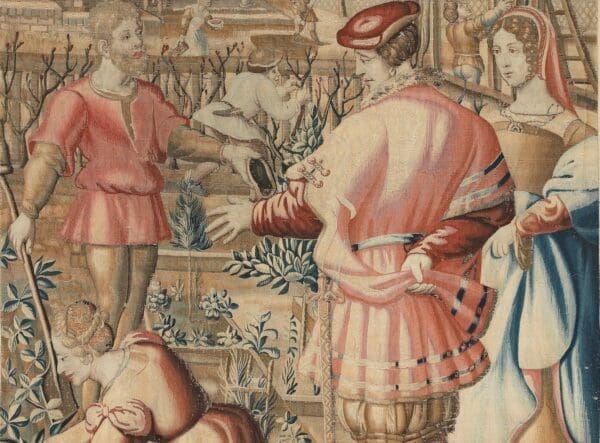
With the help of supporters and the Art Fund, the Garden Museum purchased the tapestry auction in July 2023. The finely woven tapestry depicts gardeners working and welcoming their patrons and is one of the only surviving group of tapestries from a series in the collection of the Musei di Strada Nuova in Genova. A rare example of gardening history, the tapestry shows a head gardener and his wife hard at work, greeting the wealthy homeowner and his wife amongst an array of plants, beds and trellises. The tapestry is the Garden Museum’s earliest depiction of a woman gardening, and they now ask for support to undertake the conservation needed to put this unique piece of gardening history on display.
Currently too delicate to be on permanent display, the Garden Museum are looking to conserve the tapestry and display it to visitors for the first time in the Garden Museum’s Ark Gallery, alongside the displays exploring the life and collection of John Tradescant (c.1580 -1638).
Made in around 1630, by the weaving workshop at Mortlake on the river Thames which produced the best tapestries in Europe. The tapestry depicts the month of March and is from a set celebrating different agricultural occupations across 12 months of the year, with the March scene celebrating gardening. The tapestry captures the essence of spring through blooming narcissus and buds on the fruit trees. The head gardener is shown doffing his cap to the landowners and introducing them to the delights of the garden whilst his wife is kneeling and planting seedlings. A number of undergardeners are depicted carrying out tasks around the garden such as digging new beds and tying plants into trellises. Very little is known of female gardeners in the 17th century, so the tapestry is an incredibly rich and significant record, teaching us about gardening at the time, and the important role that women played.

The conservation project is expected to take several months. Sections of threads have moved, slits between the areas of weaving have opened, folds from having been previously hung have caused tension within the surface, and old repairs are failing. The Garden Museum are looking for support to raise the £20,000 to undertake the urgent conservation work needed and to put this vital piece of gardening history on display.

